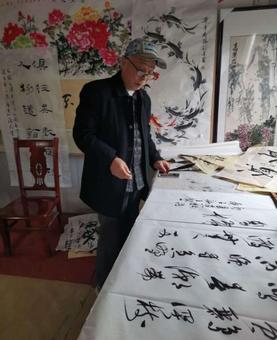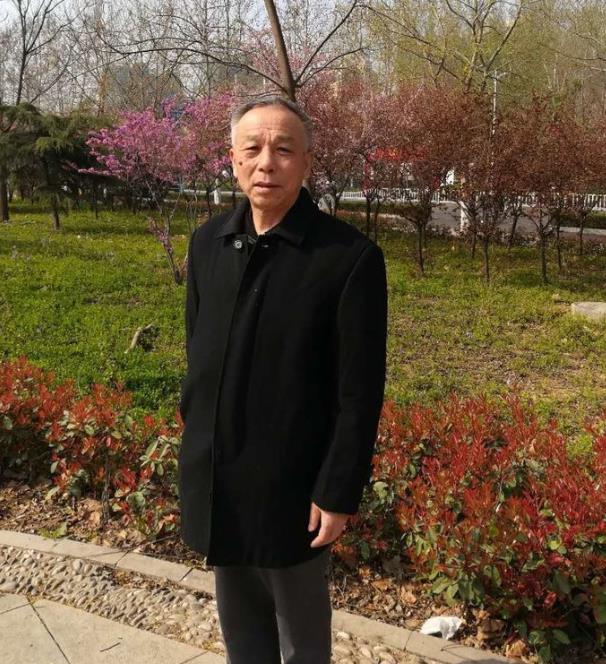Li Xinsheng
Li Xinsheng
Personal Profile
Li Xinsheng: Council Member of the Shandong Calligraphers Association, Vice Chairman of the Jining Calligraphy and Painting Association. Calligrapher of Shandong Lan Zhu Academy of Painting and Calligraphy, Senior Calligraphy Instructor of the Chinese Hard Pen Calligraphers Association,Member of the China Oriental Giant Dragon Calligraphers and Artists Research Association.
Calligrapher Li Xinsheng, styled Gongpu, pseudonym Qingfeng Hall Master, native of Jining, Shandong. Born in 1954 into a scholarly family, he apprenticed under Mr. Quan Gengchang in his youth, specializing in clerical script (Lishu), and extensively studied Han dynasty stele inscriptions preserved in historical cities such as Jining and Qufu. In the 1980s, he began practicing Han bamboo-slip scripts.
For over fifty years, he has continuously practiced and contemplated calligraphy without pause. During this time, he received careful guidance from renowned Shandong calligraphers including Bao Beiwu, Jiang Weisong, Wei Qihou, Liu Chengkai, Zhang Pengzhou, and Xu Yeling. Under the mentorship and personal instruction of these masters, Li Xinsheng’s clerical script developed a distinctive artistic style characterized by liveliness, antiquity, and elegant grace. Through years of studying and practicing Wei steles and Han bamboo slips, he diligently copied classical clerical works such as the “Cao Quan Stele,” “Zhang Qian Stele,” “Shi Chen Stele,” “Xixia Ode,” “Shimen Ode,” “Liqi Stele,” “Huashan Stele,” and the locally preserved “Zhenggu Stele” in Jining, internalizing their diverse artistic features. The “Zhang Qian Stele” appears ancient, simple, grand, and solemn, exuding a somewhat imposing aura. The “Shi Chen Stele” features square and orderly structure, dignified elegance, and restrained brushwork, yet seems somewhat lacking in liveliness. The “Cao Quan Stele” is graceful and elegant, with well-proportioned characters neither eccentric nor bizarre, yet perhaps somewhat overly pleasing.
Li Xinsheng selected strengths from each according to his own aesthetic standards for clerical script, combining them with the lively, unrestrained forms of Han bamboo slips—particularly the characteristic “silkworm head and swallow tail” strokes—to forge his own unique clerical script style. Innovation in calligraphy without deep traditional foundations is undoubtedly unfeasible. Clerical script evolved from seal script, while regular, running, and cursive scripts in turn emerged from clerical script; Han bamboo slips played a vital transitional role in this evolution from clerical to regular script. Li Xinsheng’s calligraphy, whether in clerical or cursive styles, reflects the influence of Han bamboo slips; meanwhile, his seal script works, especially those in oracle bone and bronze inscriptions, demonstrate profound traditional mastery and rich artistic flavor. In 2001, Li Xinsheng participated in a ten-artist calligraphy and painting exhibition hosted by the Shandong Lan Zhu Academy of Painting and Calligraphy, and has also frequently exhibited in national and provincial-level calligraphy exhibitions. His works have been included in publications such as “One Thousand Chinese Calligraphers and Painters,” “Collection of Chinese Hard Pen Calligraphy Works,” and “Grand Dictionary of Chinese Song Ci Calligraphy.” His calligraphy has been collected and circulated in the United States, Singapore, Hong Kong, Taiwan, Malaysia, Japan, and other regions.
For over fifty years, he has continuously practiced and contemplated calligraphy without pause. During this time, he received careful guidance from renowned Shandong calligraphers including Bao Beiwu, Jiang Weisong, Wei Qihou, Liu Chengkai, Zhang Pengzhou, and Xu Yeling. Under the mentorship and personal instruction of these masters, Li Xinsheng’s clerical script developed a distinctive artistic style characterized by liveliness, antiquity, and elegant grace. Through years of studying and practicing Wei steles and Han bamboo slips, he diligently copied classical clerical works such as the “Cao Quan Stele,” “Zhang Qian Stele,” “Shi Chen Stele,” “Xixia Ode,” “Shimen Ode,” “Liqi Stele,” “Huashan Stele,” and the locally preserved “Zhenggu Stele” in Jining, internalizing their diverse artistic features. The “Zhang Qian Stele” appears ancient, simple, grand, and solemn, exuding a somewhat imposing aura. The “Shi Chen Stele” features square and orderly structure, dignified elegance, and restrained brushwork, yet seems somewhat lacking in liveliness. The “Cao Quan Stele” is graceful and elegant, with well-proportioned characters neither eccentric nor bizarre, yet perhaps somewhat overly pleasing.
Li Xinsheng selected strengths from each according to his own aesthetic standards for clerical script, combining them with the lively, unrestrained forms of Han bamboo slips—particularly the characteristic “silkworm head and swallow tail” strokes—to forge his own unique clerical script style. Innovation in calligraphy without deep traditional foundations is undoubtedly unfeasible. Clerical script evolved from seal script, while regular, running, and cursive scripts in turn emerged from clerical script; Han bamboo slips played a vital transitional role in this evolution from clerical to regular script. Li Xinsheng’s calligraphy, whether in clerical or cursive styles, reflects the influence of Han bamboo slips; meanwhile, his seal script works, especially those in oracle bone and bronze inscriptions, demonstrate profound traditional mastery and rich artistic flavor. In 2001, Li Xinsheng participated in a ten-artist calligraphy and painting exhibition hosted by the Shandong Lan Zhu Academy of Painting and Calligraphy, and has also frequently exhibited in national and provincial-level calligraphy exhibitions. His works have been included in publications such as “One Thousand Chinese Calligraphers and Painters,” “Collection of Chinese Hard Pen Calligraphy Works,” and “Grand Dictionary of Chinese Song Ci Calligraphy.” His calligraphy has been collected and circulated in the United States, Singapore, Hong Kong, Taiwan, Malaysia, Japan, and other regions.

para-title
TAG:
Li Xinsheng

 中文
中文  en
en 
